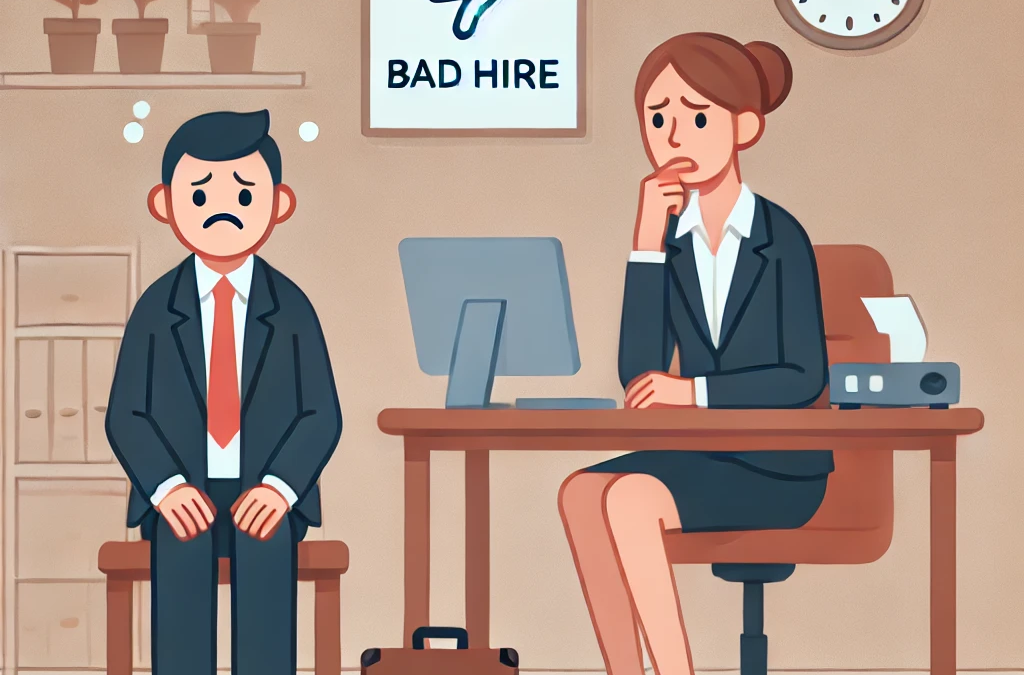Have you thought about the cost of a bad hire? Whether you’re doing the hiring yourself or relying on your employees, you may not realize how costly a poor hiring decision can be. There isn’t an immediate invoice that shows the damage, but the impact of a bad hire is evident in your financial statements. Employee turnover costs can hit multiple areas of your business:
- Advertising expenses for job boards, job fairs, employee referral rewards, etc.
- Recruitment costs related to your HR team’s time spent posting ads, screening resumes, phone interviews, testing, and reference checking.
- Lost time in training (paying both the trainer and the trainee).
- Lost time re-training replacements due to failed hires.
- Lost productivity, which leads to revenue losses.
- Poor customer service caused by ineffective employees, leading to additional revenue loss.
- Unemployment tax costs from terminated employees.
- Potential increases in unemployment tax rates that could affect your business for years.
- Negative effects on employee morale when a bad hire disrupts the workplace.
Effective Recruitment Process to Avoid a Bad Hire
To avoid the significant cost of hiring mistakes, developing better strategies for hiring the right people is essential. Implementing the following tactics can improve your recruitment process and minimize bad hire costs:
- Write targeted job ads that highlight what makes your company a great place to work, clearly state the job expectations, and list necessary qualifications.
- Ensure proper vetting through comprehensive screening, interviewing, testing, and reference-checking techniques.
- Use a standardized set of behavioral-based interview questions to assess candidates consistently.
- Incorporate personality-based and skills-based testing tools to gauge compatibility with your company and the role.
- Check references to confirm the candidate’s history and suitability for the position.
- Conduct background checks to minimize risks and ensure a reliable hire.
- Create a standardized hiring protocol to follow for every candidate to maintain consistency.
- Develop intake questionnaires for initial phone screenings to filter candidates early in the process.
- Build a strong onboarding process to ensure new hires are set up for success from day one.
- Clearly set job performance expectations so new hires understand their roles and responsibilities.
- Consider using third-party recruitment experts to assist with screening, testing, and vetting candidates so you can focus on your core business and reduce employee turnover costs.
Example of the Financial Impact of a Bad Hire
Using an online tool like the ADP Bad Hire Calculator, you can quickly estimate the true cost of a bad hire. Here’s an example scenario:
- Number of ads placed = 1
- Cost of ad placed = $450
- HR hours involved = 25
- HR staff salary = $40,000
- Average salary of interviewers = $40,000
- Number of candidates interviewed = 5
- Number of interviewers = 2
- Number of months spent training = 2
- Productivity losses (based on position’s salary) = $30,000
Total Cost of Bad Hire = $56,215.23
Minimizing hiring mistakes can save your business thousands of dollars in lost productivity and wasted resources. By refining your recruitment process and using tools to better evaluate candidates, you can avoid the high cost of a bad hire.
Frequently Asked Questions
What is the financial impact of a bad hire on a business?
A bad hire can significantly affect a business through advertising costs, training expenses, productivity losses, and even long-term unemployment tax increases. These hidden costs often add up to tens of thousands of dollars.
How can a standardized hiring process help reduce hiring mistakes?
A standardized hiring process ensures consistency, reduces bias, and helps thoroughly vet candidates through structured interviews, tests, and reference checks, leading to better hiring decisions.
What tools can businesses use to estimate the cost of a bad hire?
Businesses can use tools like the ADP Bad Hire Calculator to estimate the financial losses caused by a bad hire, helping them understand the importance of improving their recruitment processes.
How does employee turnover impact workplace morale?
High turnover disrupts team dynamics and lowers morale, as remaining employees may feel overburdened or uncertain about their own job security.
What role does onboarding play in employee success?
An effective onboarding process sets clear expectations and equips new hires with the tools and knowledge they need to succeed, reducing the likelihood of turnover and costly hiring mistakes.
Why should businesses consider using third-party recruitment experts?
Third-party recruitment experts bring experience, tools, and resources to help screen, test, and vet candidates efficiently, saving businesses time and reducing the risk of a poor hire.
What are some key strategies for improving job ads?
Effective job ads should clearly outline job responsibilities, qualifications, and benefits while highlighting why the company is a great place to work. This helps attract the right candidates.
How can behavioral-based interview questions improve hiring decisions?
Behavioral-based questions help assess a candidate’s past experiences and decision-making skills, providing insights into how they may perform in the role and fit into the company culture.
What is the importance of personality and skills testing during recruitment?
Personality and skills tests help identify candidates who are not only technically qualified but also a good cultural fit, reducing the likelihood of turnover and ensuring long-term success.
How does Accurate Placement assist businesses in improving their hiring process?
Accurate Placement specializes in providing staffing, recruitment, and screening services to help businesses in Phoenix find the right talent efficiently, saving time and money while reducing hiring risks.




